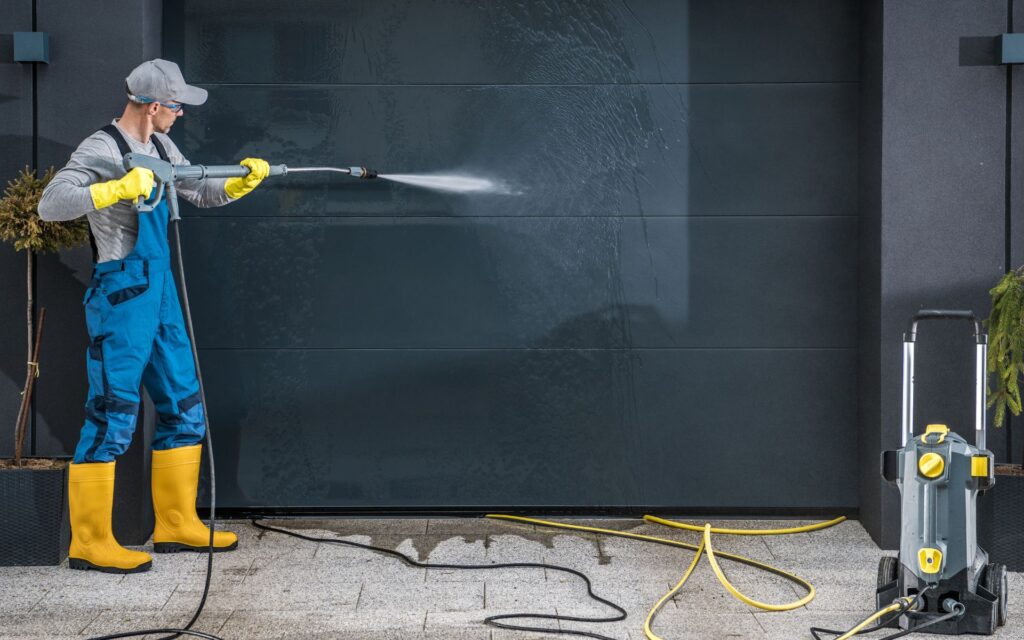
Garage doors take a beating from the elements — dirt, pollen, salt, mold, and grime all collect over time. Whether your doors are steel, vinyl, aluminum, or wood, pressure washing can be a great way to bring them back to life. But if you’re not careful, you could damage paint, warp panels, or push water into places it doesn’t belong. 😬
So, what’s the best way to pressure wash your garage doors safely and effectively? Let’s break it down. 🧼🔧
🧽 Why Pressure Wash Garage Doors?
Garage doors are one of the largest exterior surfaces on your home, and often the most neglected. Pressure washing can help:
✅ Remove built-up dirt, mildew, bird droppings, cobwebs, and road grime
✅ Improve curb appeal almost instantly
✅ Extend the lifespan of your paint or finish
✅ Prep the surface for repainting or resealing
Even a quick clean can make a huge difference — especially on lighter-colored doors that show grime more easily. 🚪✨
🛠️ Choose the Right Equipment
You don’t need industrial equipment to clean garage doors. But you do need to use the right settings and attachments:
- PSI: Stick with 1300–2000 PSI. Too much pressure can damage the surface or push water into seals and joints.
- Nozzle: Use a 25° (green) or 40° (white) nozzle. These offer good coverage without concentrating too much force.
- Extension wand: Optional, but helpful for reaching tall garage doors without a ladder.
⚠️ Avoid the 0° nozzle — it’s too aggressive for garage door materials and can chip paint or even dent panels.
Browse Amazon Here For Top Rated Power Washers And Accessories
🧼 Step-by-Step: Pressure Washing Garage Doors
1. Inspect the Door First 🧐
Look for loose paint, rust, cracks, or damaged weather stripping. If you find any issues, fix them before washing to avoid making things worse.
2. Clear the Area
Move cars, tools, and bikes out of the way. Protect nearby plants 🌿 or walls with plastic sheeting if needed.
3. Pre-Rinse with Water 💧
Spray down the door to remove loose dirt and prep the surface for detergent.
4. Apply a Cleaning Solution 🧴
Use a mild detergent that’s safe for painted or metal surfaces. Apply from the bottom up using the low-pressure soap setting or a foam cannon. Let it sit for 5–10 minutes.
5. Scrub If Needed 🧽
For really dirty spots (like under the handle or along the trim), use a soft brush or sponge.
6. Rinse with Pressure Washer
Start at the top and work your way down in overlapping sections. Keep the nozzle about 12–18 inches away from the surface, and spray at a slight angle — not straight on.
7. Dry the Door
Wipe the door with a microfiber towel or let it air dry. Make sure seals and grooves aren’t holding water. 💨
🎨 Caution: Painted and Wooden Doors
- Painted metal or wooden doors should be handled with care.
- Too much pressure can strip paint or force water under the surface.
- Consider using lower pressure and a 40° nozzle.
- Never spray water directly into the seams or joints — it can seep behind panels and cause warping or rot over time.
🪵 Wood doors especially need gentle cleaning and drying — then a coat of sealant or paint afterward for protection.
🔁 How Often Should You Pressure Wash Your Garage Door?
Once or twice a year is usually enough. But if you live in a dusty or coastal area, or you park near lots of trees (think sap or bird droppings 🐦), you might want to do it more often.
Spring and early fall are great times — you’ll clean off seasonal dirt without freezing temps getting in the way. ❄️➡️☀️
♻️ Bonus Tip: Use Eco-Friendly Cleaners
If runoff from your driveway flows toward storm drains or gardens, choose a biodegradable detergent. You’ll still get great cleaning power — without harming local plants or waterways. 🌎💚
✅ Final Thoughts
Pressure washing your garage doors can give your whole house a cleaner, fresher look — in under an hour. Just follow these rules:
✅ Use moderate pressure (1300–2000 PSI)
✅ Choose the right nozzle (25° or 40°)
✅ Work from top to bottom and avoid spraying into seams
✅ Use gentle soap and dry thoroughly
It’s a quick weekend job that pays off in big curb appeal — and helps protect one of the biggest doors in your home. 🚪🧼🎯
Browse Amazon Here For Top Rated Power Washers And Accessories






